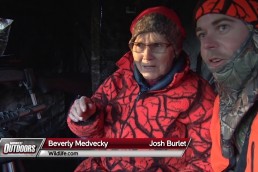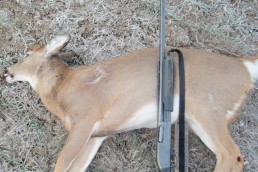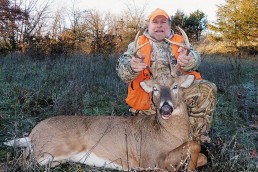December Deer Hunting
SHARE THIS POST
Hunting Deer in December
The twelfth month of the year can prove to be a special time for the unlucky hunter who has yet to score on a whitetail deer. Many states of the upper Midwest offer special seasons consisting of gun (including rifle, handgun and shotgun) and muzzle-loading seasons. So we are given three times more opportunities for success than exist in either the previous or the following months.
Yet even with the extended days for hunting, it is wise to remember that the deer we are hunting are under more stress than they face at any other time of the year. Believe it or not, the stress created by hunting is only a small factor in the equation for survival in this typically cold, snowy month.
Whitetail deer tend to be creatures of habit. If not bothered, they tend to follow pretty much the same daily routine, varying it only when forced to by the weather or the lack of available food.
A deer needs to eat about 10 to 12 pounds of food a day to stay healthy and retain its fat reserves. While the list of browse and vegetation they will consume is extensive, it is narrowed considerably late in the season, when cold winds blow and snow blankets the ground.
Winter Deer Hunting
Snow can mean many things to a deer. It can force them to move, or it can force them to “hole up” and remain stationary for days. An especially deep snow may cause them to abandon their regular haunts and move into thick swamps, or the deep cuts along riverbanks. In the flatlands, the incessant winds that accompany arriving snowstorms can bring a virtual halt to whitetail movements for days at a time.
Compounded with the cold weather is the additional stress of the rut that begins in November and continues into December, culminating with animals that have lost weight, in some cases are nearly exhausted, and are ill-equipped to face the winter months.
Deer patterns during winter
A deer’s metabolism does not respond to cold weather in the same way as a human’s. Buck deer, which almost always are larger than does, have a higher metabolic rate than the smaller animals, causing them to burn up their body reserves faster. Thus, unless they have a very good food supply going into the winter, which rarely is the case, they will face a greater chance of dying of starvation or being killed by predators.
Are you enjoying this post?
You can be among the first to get the latest info on where to go, what to use and how to use it!
As cold temperatures decrease, the deer’s metabolic rate drops, causing them to lose more body weight. Until I realized this, I always hunted deer under the assumption that a deer was just a deer, and one of either sex would provide some tasty meat in the freezer. Since I never considered myself to be a trophy hunter, scoring on a big buck with a massive rack was not a priority. It still is not, but now I understand some additional reasons why it is more important to harvest more bucks than does. In addition to being the breeding stock, the does stand a better chance of surviving a harsh winter.
What does this knowledge have to do with increasing a hunter’s odds for success? Plenty. Bucks instinctively know that when severe weather threatens, they need to preserve their fat reserves. During a heavy snowstorm and high winds, deer will lie down and not move, perhaps for days if they are not disturbed by hunters or large predators. Since their hollow-haired coats provide good insulation, the snow will pile up around them, making them even more difficult to spot. Deer are creatures of habit, and as a rule they will return to the same bedding areas they have used before. They paw down to the leaves or high grass, lie down on it and remain there until the storm passes.
Winter deer habits
Other habits do change. In the winter months, deer tend to be more active during the daylight hours. They remain bedded during the long, cold night, sometimes until the sun has risen, when they begin to forage for food. Fields of standing corn, if any remain, attract deer like a magnet. The best buck I ever shot during my state’s shotgun season emerged from a picked corn field at around 9 a. m. I knew he had foraged that morning, because his stomach contained intact kernels of field corn. That plump 8-point tasted mighty fine. Remaining stationary during the night helps preserve body fat, and so does feeding during the warmer hours.
So, where to look for a deer in the winter? Deer like to avoid the wind when they can, so they will go into the thickest cover they can find, where the snow is the thinnest. Snow depth there will be the lightest, because much of the fallen snow remains on tree limbs. When the snow melts, the areas under the trees will be fairly clear. The branches and surrounding brush will help hold the animal’s heat, rather than letting it dissipate in the wind.
The buck I mentioned earlier lived in an area where two woods met, ditches provided a minimum amount of water, corn and acorns provided fat-rich food, and massive old brush piles and thickets of thorny rose bushes provided avenues of escape and shelter from the wind. I dressed for the weather, kept the wind in my face, watched and listened and did not move. All low-tech, centuries-old hunting strategies that still work, just like they did for our paleolithic ancestors.
On that cold December morning, that ol’ bucks’ luck ran out, and I hit the jackpot.
MWO
SHARE THIS POST
Did you enjoy this post?
You can be among the first to get the latest info on where to go, what to use and how to use it!
John Bennett
John Bennett is a retired history teacher, historical re-enactor, father and grandfather. As a four-season outdoorsman, his passion is waterfowl hunting and fishing for smallmouth bass. He lives in Ohio and spends quite a bit of time in his primitive log cabin, which he built.



